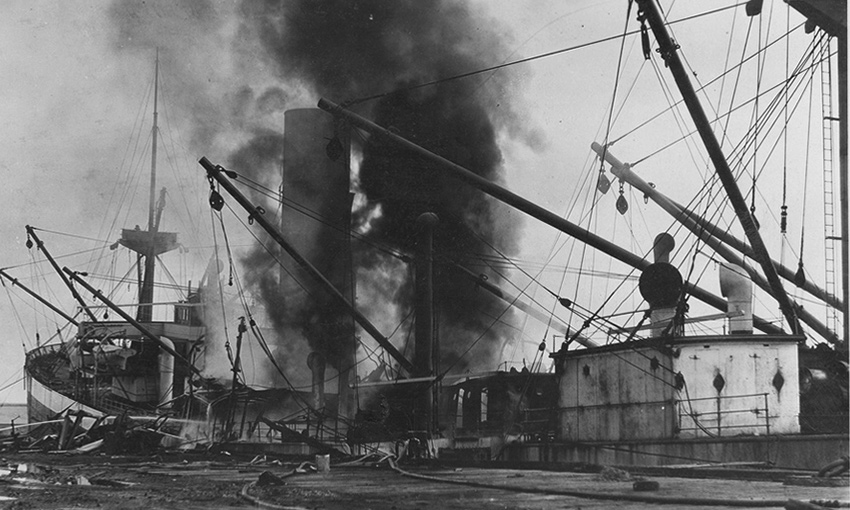ONE evening in April 1924 the ship City of Singapore caught fire at Port Adelaide, causing an explosion which killed three firemen and injured ten others, along with two crewmembers.
The Ellerman Bucknall Line steamer had sailed from New York with 2600 tons of cargo to discharge. First there was a fire, then what Daily Commercial News described as “a terrific explosion” which echoed through the pages of DCN and many other Australian newspapers one hundred years ago.
“It was on the night of April 26 that the steamer caught fire while docked at the No.2 Quay, Port Adelaide,” DCN reported later in 1924, once the story had further developed.
“She was from New York, via Sydney and Melbourne, with a cargo of motor cars, benzine, and so forth, and upon completion of discharge there was to have gone to Fremantle with the balance of her inward cargo.
“At the same time, and pending the complete discharge of the American freight, breadstuffs and freight lines were being loaded. At first it was thought that the fire, and subsequent explosions, which cost the lives of several firemen of the Metropolitan Fire Brigades, and caused injuries to many others, had occurred among the benzine, and that the bulk oil in the deep tank amidships had been blown up, but subsequent official enquiries pointed to spontaneous combustion among the coal.”
SURVEYING THE DAMAGE
The fire was under control by 29 April, but the ship had buckled, and the cargo had been destroyed.
Mount Gambier newspaper Border Watch that day reported in rather vivid detail the “appalling tragedy” at the port.
According to the South Australian paper, the explosion had occurred after a series of smaller explosions, and “at a moment when the fire chiefs were congratulating themselves on a miraculous save”.
“Three firemen were hurled to their doom and 10 others were injured, in addition to members of the crew,” Border Watch wrote.
“The intense heat buckled the plates and broke the back of the steamer, which is as complete a wreck as through she had been driven ashore on a coral reef.
“The whole of the amidships section of the ship was gutted, and the engineer’s quarters were completely burnt out. The concussion from the explosion was so stupendous that it rattled windows and doors as far away as the foothills, and many residents thought there had been a severe earthquake.
“Never previously in the history of Port Adelaide has a more thrilling episode occurred in connection with shipping than on Saturday night.”
THE CHIEF OFFICER’S ESCAPE
Chief officer Dickie of the Metropolitan Fire Brigade survived the explosion, but only after he escaped the cabin he had become trapped in. He told Border Watch the force of the explosion had distorted the cabin door, and he needed to find another opening to get out.
“How the captain got, out I do not know,” chief officer Dickie said.
“I wandered through the alleyways right up to the heart of the blazing inferno. Eventually I got up into the saloon, where I was fortunate in finding one of the portholes which would unscrew.
“There was the fire raging fiercely around me, and only the small porthole offering any hope of escape. I did not know when another explosion would occur, so I set vigorously to work to worm my way out through the porthole. How I managed to get through, I do not know, but eventually I found myself on deck.
“Inwardly I said to myself it is ‘goodbye, Jackie Dickie, this time.’ By the time I found myself on deck again everybody was off the ship. I am not going to say that I was the last to leave it, but it was a considerable while after the explosion before I was able to extricate myself, and by that time all shore communication bar the mooring lines and a rope or two were gone. I looked over the side of the ship, saw a rope and lost no time in sliding down it on to the wharf.”
THE CASUALTIES
In August 1924 DCN reported that City of Singapore may be abandoned. The steamer was considered to be beyond economical reconstruction. But in December that year, the steamer was sold in Great Britain “just as she lies at the North Arm, Port Adelaide River, where she was towed, and moored some time subsequent to the disaster,” DCN wrote.
One year later, in December 1925, Ellerman Line repurchased the steamer after it was repaired and reclassed. And one hundred years later, the names of the three men who died in the City of Singapore explosion remain on a plaque at the South Australian Metropolitan Fire Service in Adelaide.
Those men were James Hickey, a 22-year-old from Ballarat; George Anderson, aged 23, from Semaphore; and 29-year-old Albert Greenman.
“The only remains found of George Anderson were some coins and buttons from his tunic, a locker key and some small pieces of firefighting equipment. The body of Albert Greenman was recovered for the Port River, but not trace of James Hickey was ever found, such was the ferocity of the blast,” the plaque says.
“This is a memorial to those gallant firefighters.”
This article appeared in the April 2024 edition of DCN Magazine





